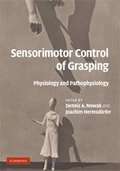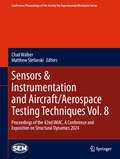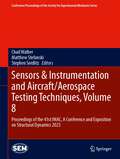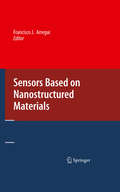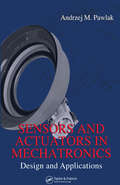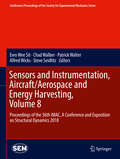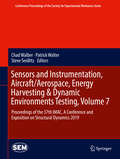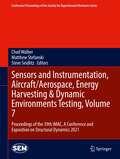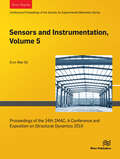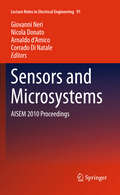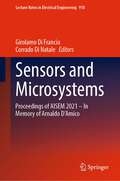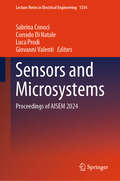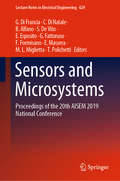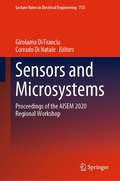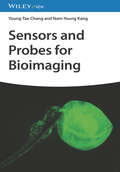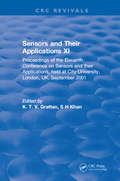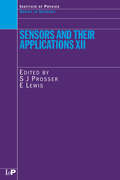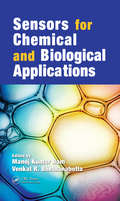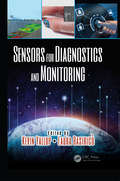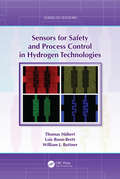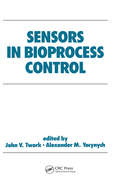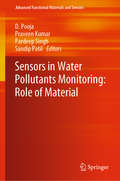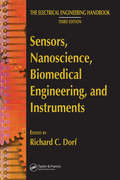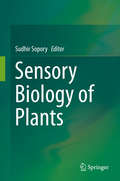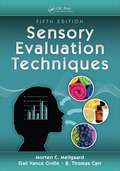- Table View
- List View
Sensorimotor Control of Grasping: Physiology and Pathophysiology
by Dennis A. Nowak Joachim HermsdörferThe human hand can take on a huge variety of shapes and functions, providing its owner with a powerful hammer at one time or a delicate pair of forceps at another. The universal utility of the hand is even more enhanced by the ability to amplify the function of the hand by using tools. To understand and appreciate how the human brain controls movements of the hand, it is important to investigate both the healthy motor behaviour and dysfunction during everyday manipulative tasks. This book provides a contemporary summary of the physiology and pathophysiology of the manipulative and exploratory functions of the human hand. With contributions from scientists and clinical researchers of biomechanics, kinesiology, neurophysiology, psychology, physical medicine and rehabilitation, it covers the development of healthy human grasping over the lifespan, the wide spectrum of disability in the pathological state and links basic motor research with modern brain sciences.
Sensors & Instrumentation and Aircraft/Aerospace Testing Techniques Vol. 8: Proceedings of the 42nd IMAC, A Conference and Exposition on Structural Dynamics 2024 (Conference Proceedings of the Society for Experimental Mechanics Series)
by Chad Walber Matthew StefanskiSensors & Instrumentation and Aircraft/Aerospace Testing Techniques, Volume 8: Proceedings of the 42nd IMAC, A Conference and Exposition on Structural Dynamics, 2024, the eighth volume of ten from the Conference brings together contributions to this important area of research and engineering. The collection presents early findings and case studies on fundamental and applied aspects of Shock & Vibration, Aircraft/Aerospace Testing Techniques including papers on: Alternative Sensing & Acquisition Active Controls Instrumentation
Sensors & Instrumentation and Aircraft/Aerospace Testing Techniques, Volume 8: Proceedings of the 41st IMAC, A Conference and Exposition on Structural Dynamics 2023 (Conference Proceedings of the Society for Experimental Mechanics Series)
by Chad Walber Matthew Stefanski Stephen SeidlitzSensors & Instrumentation and Aircraft/Aerospace Testing Techniques, Volume 8: Proceedings of the 41st IMAC, A Conference and Exposition on Structural Dynamics, 2023, the eighth volume of ten from the Conference brings together contributions to this important area of research and engineering. The collection presents early findings and case studies on fundamental and applied aspects of Shock & Vibration, Aircraft/Aerospace Testing Techniques including papers on:Alternative Sensing & AcquisitionActive ControlsInstrumentation
Sensors Based on Nanostructured Materials
by Francisco J. ArreguiThis book presents the many different techniques and methods of fabricating materials on the nanometer scale, and, specifically, the utilization of these resources with regard to sensors. The techniques described are studied from an application-oriented perspective, providing the reader with a perspective of the types of nanostructured sensors available that is broader than other books which concentrate on theoretical situations related to specific fabrication techniques.
Sensors and Actuators in Mechatronics: Design and Applications
by Andrzej M PawlakFrom large-scale industrial systems to components in consumer applications, mechatronics has woven itself into the very fabric of modern technology. Among the most important elements of mechatronic systems are electromagnetic sensors and electromechanical actuators. Cultivated over years of industrial and research experience, Sensors and Actuators in Mechatronics: Design and Applications builds a practical understanding of the features and functions of various electromagnetic and electromechanical devices necessary to meet specific industrial requirements.This work focuses on various components that receive less attention in the available literature, such as magnetic sensors, linear and latching solenoid actuators, stepper motors, rotary actuators, and other special magnetic devices including magnetic valves and heart pumps. Each chapter follows a consistent format, working from theory to design, applications, and numerical problems and solutions. Although the crux of the coverage is design and application, the author also discusses optimization and testing, introduces magnetic materials, and shares his enlightened perspective on the social and business aspects of developing world-class technologies. Examples from mainly the automotive industry illustrate the wide variety of mechatronic devices presented.Providing a complete picture from conception to completion, Sensors and Actuators in Mechatronics: Design and Applications places critical tools in the hands of any researcher or engineer seeking to develop innovative mechatronic systems.
Sensors and Instrumentation, Aircraft/Aerospace and Energy Harvesting , Volume 8: Proceedings Of The 36th Imac, A Conference And Exposition On Structural Dynamics 2018 (Conference Proceedings of the Society for Experimental Mechanics Series)
by Evro Wee Sit Alfred Wicks Chad Walber Patrick Walter Steve SeidlitzSensors and Instrumentation, Volume 8. Proceedings of the 36th IMAC, A Conference and Exposition on Structural Dynamics, 2018, the eighth volume of nine from the Conference brings together contributions to this important area of research and engineering. The collection presents early findings and case studies on fundamental and applied aspects of Sensors and Instrumentation, including papers on:Sensor ApplicationsAccelerometer DesignAccelerometer CalibrationSensor Technology Energy Harvesting TechnologyAircraft/Aerospace Technology
Sensors and Instrumentation, Aircraft/Aerospace, Energy Harvesting & Dynamic Environments Testing, Volume 7: Proceedings of the 37th IMAC, A Conference and Exposition on Structural Dynamics 2019 (Conference Proceedings of the Society for Experimental Mechanics Series)
by Chad Walber Patrick Walter Steve SeidlitzSensors and Instrumentation, Aircraft/Aerospace and Energy Harvesting, Volume 7: Proceedings of the 37th IMAC, A Conference and Exposition on Structural Dynamics, 2019, the seventh volume of eight from the Conference brings together contributions to this important area of research and engineering. The collection presents early findings and case studies on fundamental and applied aspects of Shock & Vibration, Aircraft/Aerospace, Energy Harvesting & Dynamic Environments Testing including papers on:Alternative Sensing & AcquisitionActive ControlsInstrumentationAircraft/Aerospace & Aerospace Testing Techniques Energy Harvesting
Sensors and Instrumentation, Aircraft/Aerospace, Energy Harvesting & Dynamic Environments Testing, Volume 7: Proceedings of the 39th IMAC, A Conference and Exposition on Structural Dynamics 2021 (Conference Proceedings of the Society for Experimental Mechanics Series)
by Chad Walber Steve Seidlitz Matthew StefanskiSensors and Instrumentation, Aircraft/Aerospace and Energy Harvesting, Volume 7: Proceedings of the 39th IMAC, A Conference and Exposition on Structural Dynamics, 2021, the seventh volume of nine from the Conference brings together contributions to this important area of research and engineering. The collection presents early findings and case studies on fundamental and applied aspects of Shock & Vibration, Aircraft/Aerospace, Energy Harvesting & Dynamic Environments Testing including papers on:Alternative Sensing & AcquisitionActive ControlsInstrumentationAircraft/Aerospace & Aerospace Testing Techniques Energy Harvesting
Sensors and Instrumentation, Volume 5: Proceedings of the 34th IMAC, A Conference and Exposition on Structural Dynamics 2016
by Evro Wee SitSensors and Instrumentation, Volume 5. Proceedings of the 34th IMAC, A Conference and Exposition on Dynamics of Multiphysical Systems: From Active Materials to Vibroacoustics, 2016, the fifth volume of ten from the Conference brings together contributions to this important area of research and engineering. The collection presents early findings and case studies on fundamental and applied aspects of Structural Dynamics, including papers on: Experimental Techniques Smart Sensing Rotational Effects Dynamic Calibration Systems & Sensing Technologies Modal Transducers Novel Excitation Methods.
Sensors and Microsystems
by Corrado Di Natale Arnaldo D'Amico Giovanni Neri Nicola DonatoSensors and Microsystems contains a selection of papers presented at the 15th Italian Conference on Sensors and Microsystems. It provides a unique perspective on the research and development of sensors, microsystems and related technologies in Italy. The scientific values of the papers also offers an invaluable source to analysts intending to survey the Italian situation about sensors and microsystems. In an interdisciplinary approach many aspects of the disciplines are covered, ranging from materials science, chemistry, applied physics, electronic engineering and biotechnologies.
Sensors and Microsystems: Proceedings of AISEM 2021 – In Memory of Arnaldo D’Amico (Lecture Notes in Electrical Engineering #918)
by Corrado Di Natale Girolamo Di FranciaThis book showcases the state of the art in the field of sensors and microsystems, revealing the impressive potential of novel methodologies and technologies. It covers a broad range of aspects, including: bio-, physical and chemical sensors, actuators, micro- and nano-structured materials, mechanisms of interaction and signal transduction, polymers and biomaterials, sensor electronics and instrumentation, analytical microsystems, recognition systems and signal analysis and sensor networks as well as manufacturing technologies, environmental, food, energy and biomedical applications. The contents reflect the outcomes of the activities of AISEM (Italian Association of Sensors and Microsystems) in 2021. Co-Edited by B. Andò, F. Baldini, G. Betta, D. Compagnone, S. Conoci, E. Comini, V. Ferrari, E. La Salandra, L. Lorenzelli, A.G. Mignani, G. Marrazza, G. Neri, P. Siciliano.
Sensors and Microsystems: Proceedings of AISEM 2024 (Lecture Notes in Electrical Engineering #1334)
by Corrado Di Natale Luca Prodi Sabrina Conoci Giovanni ValentiThis book showcases the state of the art in the field of sensors and microsystems, revealing the impressive potential of novel methodologies and technologies. It covers a broad range of aspects, including: bio-, physical and chemical sensors; actuators; micro- and nano-structured materials; mechanisms of interaction and signal transduction; polymers and biomaterials; sensor electronics and instrumentation; analytical microsystems, recognition systems and signal analysis; and sensor networks, as well as manufacturing technologies, environmental, food and biomedical applications. The book gathers a selection of papers presented at the 22nd AISEM National Conference on Sensors and Microsystems, held in Bologna, Italy, in February 2024, which brought together researchers, end users, technology teams and policymakers.
Sensors and Microsystems: Proceedings of the 20th AISEM 2019 National Conference (Lecture Notes in Electrical Engineering #629)
by G. Di Francia C. Di Natale B. Alfano S. De Vito E. Esposito G. Fattoruso F. Formisano E. Massera M. L. Miglietta T. PolichettiThis book showcases the state of the art in the field of sensors and microsystems, revealing the impressive potential of novel methodologies and technologies. It covers a broad range of aspects, including: bio-, physical and chemical sensors; actuators; micro- and nano-structured materials; mechanisms of interaction and signal transduction; polymers and biomaterials; sensor electronics and instrumentation; analytical microsystems, recognition systems and signal analysis; and sensor networks, as well as manufacturing technologies, environmental, food and biomedical applications. The book gathers a selection of papers presented at the 20th AISEM National Conference on Sensors and Microsystems, held in Naples, Italy in February 2019, the event brought together researchers, end users, technology teams and policy makers.
Sensors and Microsystems: Proceedings of the AISEM 2020 Regional Workshop (Lecture Notes in Electrical Engineering #753)
by Corrado Di Natale Girolamo Di FranciaThis book showcases the state of the art in the field of sensors and microsystems, revealing the impressive potential of novel methodologies and technologies. It covers a broad range of aspects, including: bio-, physical and chemical sensors, actuators, micro- and nano-structured materials, mechanisms of interaction and signal transduction, polymers and biomaterials, sensor electronics and instrumentation, analytical microsystems, recognition systems and signal analysis and sensor networks as well as manufacturing technologies, environmental, food, energy and biomedical applications. The book gathers a selection of papers presented at the AISEM Regional Workshop on Sensors and Microsystems, held in Portici (Naples), Italy in February 2020.
Sensors and Probes for Bioimaging
by Young-Tae Chang Nam-Young KangSensors and Probes for Bioimaging A fulsome exploration of the history, design, and application of bioimaging probes and sensors In Sensors and Probes for Bioimaging, distinguished researcher Professor Young-Tae Chang and Professor Nam-Young Kang deliver a comprehensive discussion of bioimaging achieved with sensors and probes. In the book, readers will find a complete discussion of the history of colorful sensors and probes, probe design and the mechanisms of staining, as well as cell and tissue application and whole-body imaging. You’ll learn how probes can be used, how to choose and use a variety of probes, and new directions in research and application in the area of sensors and probes for bioimaging. Readers will also find: A thorough introduction to bioimaging, as well as discussions of chemical sensors and probes used in bioimaging Comprehensive explorations of organelle and cell selective probes, as well as discussions of a model for organelle selectivity Practical discussions of tissue selective probes and whole-body imaging Fulsome treatments of imaging for biological function and for the diagnosis of disease, including cancer and Alzheimer’s imaging Perfect for chemical biologists, analytical chemists, biochemists, and materials scientists, Sensors and Probes for Bioimaging will also earn a place in the libraries of clinical chemists and advanced undergraduate students, graduate students, and professionals working in the bioimaging and sensor industry.
Sensors and Their Applications XI: Proceedings Of The Eleventh Conference On Sensors And Their Applications, Held At City University, London, September 2001 (Series In Sensors Ser.)
by K. T. GrattanWith research continuing to expand and develop, the marketplace for sensors and instrumentation remains one of the most significant for the United Kingdom, the European Union, and the economies of major developed nations. Sensors and Their Applications XI discusses novel research in the field of sensors and transducers, and provides valuable insight into new and topical applications of the technology. The book records the breadth and quality of the field and acts as a topical record of work in sensors and their applications. It will serve as an invaluable reference for physicists, engineers, and chemists working in this area of technology for many years to come.
Sensors and Their Applications XII (Series in Sensors)
by S J Prosser E LewisSensors and Their Applications XII discusses novel research in the areas of sensors and transducers and provides insight into new and topical applications of this technology. It covers the underlying physics, fabrication technologies, and commercial applications of sensors. Some of the topics discussed include optical sensing, sensing materials, no
Sensors for Chemical and Biological Applications
by Venkat R. Bhethanabotla Manoj Kumar RamIn recent years, sensor research has undergone a quiet revolution that will have a significant impact on a broad range of applications in areas such as health care, the environment, energy, food safety, national security, and manufacturing. Sensors for Chemical and Biological Applications discusses in detail the potential of chemical and biological sensors and examines how they are meeting the challenges of chem-bio terrorism by monitoring through enhanced specificity, fast response times, and the ability to determine multiple hazardous substances. Exploring the nanotechnology approach, and carrying this theme throughout the book, the chapters cover the sensing principles for, chemical, electrical, chromatographic, magnetic, biological, fluidic, optical, and ultrasonic and mass sensing systems. They address issues associated with cost, synthesis, and testing of new low cost materials with high sensitivity, selectivity, robustness, and speed for defined sensor applications. The book extensively discusses the detailed analysis of future impact of chemical and biological sensors in day-to-day life. Successful development of improved chemical sensor and biosensor systems and manufacturing procedures will not only increase the breadth and depth of the sensor industry, but will spill over into the design and manufacture of other types of sensors and devices that use nanofabrication and microfabrication techniques. This reference not only supplies versatile, hands-on tools useful in a broad array of disciplines, but also lays the interdisciplinary groundwork required for the achievement of sentient processing.
Sensors for Diagnostics and Monitoring (Devices, Circuits, and Systems)
by Kevin Yallup Laura BasiricòSensor technologies and applications are evolving rapidly driven by the demand for new sensors for monitoring and diagnostic purposes to enable improvements in human health and safety. Simultaneously, sensors are required to consume less power, be autonomous, cost less, and be connected by the Internet of Things. New sensor technologies are being developed to fulfill these needs. This book reviews the latest developments in sensor technology and gives the reader an overview of the state-of-the-art in key areas, such as sensors for diagnostics and monitoring. Features Provides an overview of sensor technologies for monitoring and diagnostics applications. Presents state-of-the-art developments in selected topics for sensors that can be used for monitoring and diagnostics in future healthcare, structural monitoring, and smart environment applications. Features contributions from leading international experts in both industry and academia. Explores application areas that include medical diagnostics and screening, health monitoring, smart textiles, and structural monitoring.
Sensors for Safety and Process Control in Hydrogen Technologies (Series in Sensors)
by Thomas Hübert Lois Boon-Brett William ButtnerUnderstand, Select, and Design Sensors for Hydrogen-Based ApplicationsThe use of hydrogen generated from renewable energy sources is expected to become an essential component of a low-carbon, environmentally friendly energy supply, spurring the worldwide development of hydrogen technologies. Sensors for Safety and Process Control in Hydrogen Technologies provides practical, expert-driven information on modern sensors for hydrogen and other gases as well as physical parameters essential for safety and process control in hydrogen technologies. It illustrates how sensing technologies can ensure the safe and efficient implementation of the emerging global hydrogen market.The book explains the various facets of sensor technologies, including practical aspects relevant in hydrogen technologies. It presents a comprehensive and up-to-date account of the theory (physical and chemical principles), design, and implementations of sensors in hydrogen technologies. The authors also offer guidance on the development of new sensors based on the analysis of the capabilities and limitations of existing sensors with respect to current performance requirements.Suitable for both technical and non-technical personnel, the book provides a balance between detailed descriptions and simple explanations. It gives invaluable insight into the role sensors play as key enabling devices for both control and safety in established and emerging hydrogen technologies.
Sensors in Bioprocess Control
by John V. Twork Alexander M. YacynychThis volume presents the reader with an overview of current chemical sensor technology and outlines a framework relating industrial bioprocess monitoring to modern process control technology. It deals with conventional multivariable control technology, focusing on bioprocess applications.
Sensors in Water Pollutants Monitoring: Role of Material (Advanced Functional Materials and Sensors)
by D. Pooja Praveen Kumar Pardeep Singh Sandip PatilThis book discusses the sensitivity, selectivity, and response times of different sensor materials and their potential application in the design of portable sensor systems for monitoring water pollutants and remediation systems. Beginning with an overview on water pollutants and analytical methods for their detection, the book then moves on to describing the advances in sensor materials research, and the scope for their use in different types of sensors. The book lays emphasis on techniques such as colorimetric, fluorescence, electrochemical, and biological sensing of conventional and emerging pollutants. This book will serve as a handy guide for students, researchers, and professional engineers working in the field of sensor systems for monitoring water pollutants to address various challenges.
Sensors, Nanoscience, Biomedical Engineering, and Instruments: Sensors Nanoscience Biomedical Engineering (The Electrical Engineering Handbook)
by Richard C. DorfIn two editions spanning more than a decade, The Electrical Engineering Handbook stands as the definitive reference to the multidisciplinary field of electrical engineering. Our knowledge continues to grow, and so does the Handbook. For the third edition, it has expanded into a set of six books carefully focused on a specialized area or field of study. Each book represents a concise yet definitive collection of key concepts, models, and equations in its respective domain, thoughtfully gathered for convenient access.Sensors, Nanoscience, Biomedical Engineering, and Instruments provides thorough coverage of sensors, materials and nanoscience, instruments and measurements, and biomedical systems and devices, including all of the basic information required to thoroughly understand each area. It explores the emerging fields of sensors, nanotechnologies, and biological effects. Each article includes defining terms, references, and sources of further information. Encompassing the work of the world’s foremost experts in their respective specialties, Sensors, Nanoscience, Biomedical Engineering, and Instruments features the latest developments, the broadest scope of coverage, and new material on multisensor data fusion and MEMS and NEMS.
Sensory Biology of Plants
by Sudhir SoporyPlants provide a source of survival for all life on this planet. They are able to capture solar energy and convert it into food, feed, wood and medicines. Though sessile in nature, over many millions of years, plants have diversified and evolved from lower to higher life forms, spreading from sea level to mountains, and adapting to different ecozones. They have learnt to cope with challenging environmental conditions and various abiotic and biotic factors. Plants have also developed systems for monitoring the changing environment and efficiently utilizing resources for growth, flowering and reproduction, as well as mechanisms to counter the impact of pests and diseases and to communicate with other biological systems, like microbes and insects. This book discusses the “awareness” of plants and their ability to gather information through the perception of environmental cues, such as light, gravity, water, nutrients, touch and sound, and stresses. It also explores plants’ biochemical and molecular “computing” of the information to adjust their physiology and development to the advantage of the species. Further, it examines how plants communicate between their different organs and with other organisms, as well as the concepts of plant cognition, experience and memory, from both scientific and philosophical perspectives. Lastly, it addresses the phenomenon of death in plants.The epilogue presents an artist’s view of the beauty of the natural world, especially plant “architecture”. The book provides historical perspectives, comparisons with animal systems where needed, and general biochemical and molecular concepts and themes. Each chapter is selfcontained, but also includes cross talk with other chapters to offer an integrated view of plant life and allow readers to appreciate and admire the functioning of plant life from within and without. The book is a tribute by the Editor to his students, colleagues and co-workers and to those in whose labs he has worked.
Sensory Evaluation Techniques
by Gail Vance Civille B. Thomas CarrThis new edition of a bestseller covers all phases of performing sensory evaluation studies, from listing the steps involved in a sensory evaluation project to presenting advanced statistical methods. Like its predecessors, Sensory Evaluation Techniques, Fifth Edition gives a clear and concise presentation of practical solutions, accepted methods,
